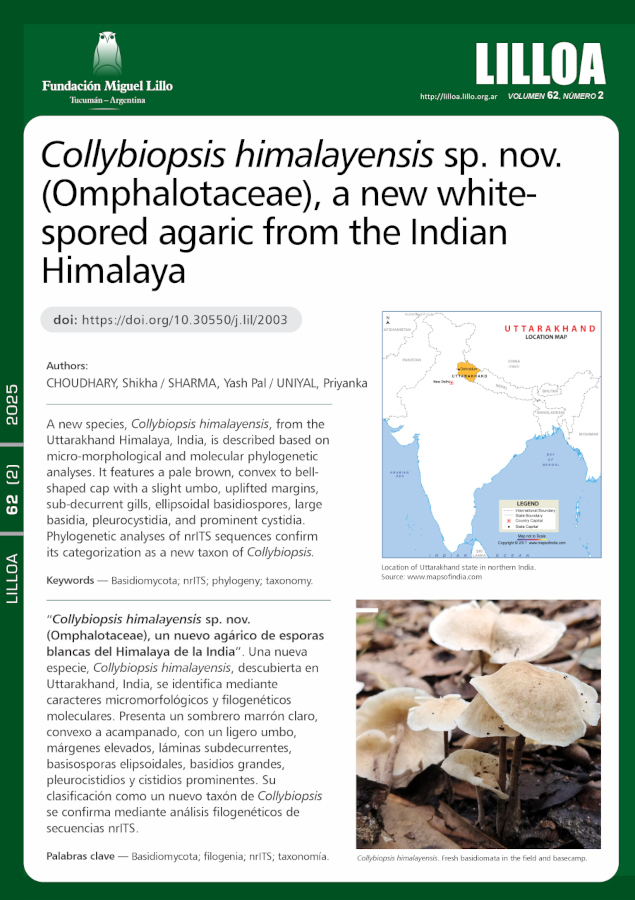Collybiopsis himalayensis sp. nov. (Omphalotaceae), a new white- spored agaric from the Indian Himalaya
DOI:
Palavras-chave:
Basidiomycota, nrITS, phylogeny, taxonomyResumo
A new species, Collybiopsis himalayensis, from the Uttarakhand Himalaya, India, is described based on micro-morphological and molecular phylogenetic analyses. This species is characterized by its convex to campanulate pileus with a slight umbo, margins uplifted, minutely pruniose surface, pale brown, sub-decurrent lamellae, sub-ellipsoidal
basidiospores, large basidia (36-51.5 × 6.6-7.9 µm), and presence of pleurocystidia and large hyphae like ileocystidia and cheilocystidia. Phylogenetic analyses of nrITS sequences confirm its categorization as a new taxon of Collybiopsis.
Downloads
Referências
Altschul, S. F., Madden T. L., Schaffer, A. A., et al. (1997). Gapped BLAST and PSI-BLAST: a new generation of protein database search programs. Nucleic Acids Research 25: 3389-3402. DOI: https://doi.org/10.1093/nar/25.17.3389
Antonín, V. & Herink, J. (1999). Notes on the variability of Gymnopus luxurians (Tricholomataceae). Czech Mycology 52 (1): 41-49. DOI: https://doi.org/10.33585/cmy.52103
Antonín, V. & Noordeloos, M. E. (1993). A Monograph of Marasmius, Collybia, and Related Genera in Europe: Marasmius, Setulipes, and Marasmiellus. Libri botanici 8: 1-229.
Clark, K., Karsch-Mizrachi, I. & Lipman, D. J. (2016). GenBank. (Database issue) Nucleic Acids Research 44 (1): D67-D72. DOI: https://doi.org/10.1093/nar/gkv1276
Desjardin, D. E., Halling, R. E. & Hemmes, D. E. (1999). Agaricales of the Hawaiian Islands. 5. The genera Rhodocollybia and Gymnopus. Mycologia 91 (1): 166-176. DOI: https://doi.org/10.1080/00275514.1999.12061006
Desjardin, D. E. & Perry, B. A. (2017). The gymnopoid fungi (Basidiomycota, Agaricales) from the Republic of São Tomé and Príncipe, West Africa. Mycosphere 8: 1317-1391. DOI: https://doi.org/10.5943/mycosphere/8/9/5
Dutta, A. K., Wilson, A. W., Antonín, V. & Acharya, K. (2015). Taxonomic and phylogenetic study on gymnopoid fungi from Eastern India. I. Mycological Progress 14 (10): 1-18. DOI: https://doi.org/10.1007/s11557-015-1094-3
Earle, F. S. (1909). The genera of the North American gill fungi. Bulletin of the New York Botanical Garden 5: 373-451.
Edler, D., Klein, J. & Antonelli, A. (2021). raxmlGUI 2.0: A graphical interface and toolkit for phylogenetic analyses using RAxML. Methods in Ecology and Evolution 12: 373-377. DOI: https://doi.org/10.1111/2041-210X.13512
Fries, E. (1835). Corpus florarum provincialium Sueciae: I. Floram scanicam (Vol. 1). Typis Palmblad, Sebell & Company. DOI: https://doi.org/10.5962/bhl.title.47083
Hughes, K. W. & Petersen, R. H. (2015), Transatlantic disjunction in fleshy fungi III: Gymnopus confluens. MycoKeys 9: 37-63. DOI: https://doi.org/10.3897/mycokeys.9.4700
Hughes, K. W., Segovia, A. R. & Petersen, R. H. (2014). Transatlantic disjunction in fleshy fungi. I. The Sparassis crispa complex. Mycological Progress 13 (2): 407-427. DOI: https://doi.org/10.1007/s11557-013-0927-1
Katoh, K. & Standley, D. M. (2013). MAFFT multiple sequence alignment software ver. 7: improvement in performance and usability. Molecular Biology and Evolution 30: 772780. DOI: https://doi.org/10.1093/molbev/mst010
Kim, J. S., Cho, Y., Park, K. H., Park, J. H., Kim, M., Kim, C. S. & Lim, Y. W. (2022). Taxonomic study of Collybiopsis (Omphalotaceae, Agaricales) in the Republic of Korea with seven new species. MycoKeys 88: 79-108. DOI: https://doi.org/10.3897/mycokeys.88.79266
Kornerup, A. & Wanscher, J. H. (1978). Methuen handbook of colour, 3rd edn. Reprinted. – Eyre Methuen.
Largent, D., Johnson, D. & Watling, R. (1977). How to identify mushrooms to genus III: microscopic features. Mad River Press Inc., Eureka, California.
Li, J. P., Pan, M. C., Li, Y., Deng, C. Y., Wang, X. M., Zhang, B. X., Li, C. T. & Li, Y. (2022). Morpho-Molecular Evidence Reveals Four Novel Species of Gymnopus (Agaricales, Omphalotaceae) from China. Journal of Fungi 8 (4): 398. DOI: https://doi.org/10.3390/jof8040398
Murrill, W. (1915). Agaricaceae (pars). Flora of North America 9: 286-296.
Oliveira, J. J., Vargas-Isla, R., Cabral, T. S., Rodrigues, D. P. & Ishikawa, N. K. (2019). Progress on the phylogeny of the Omphalotaceae: Gymnopus s. str., Marasmiellus s. str., Paragymnopus gen. nov. and Pusillomyces gen. nov. Mycological Progress 18 (5): 713-739. DOI: https://doi.org/10.1007/s11557-019-01483-5
Petersen, R. H. & Hughes, K. W. (2021). Collybiopsis and its type species, Co. ramealis. Mycotaxon 136 (2): 263-349. DOI: https://doi.org/10.5248/136.263
Retnowati, A. (2018). The species of Marasmiellus (Agaricales: Omphalotaceae) from Java and Bali. Gardens’ Bulletin Singapore 70 (1): 191-258. DOI: https://doi.org/10.26492/gbs70(1).2018-17
Singer, R. (1973). The genera Marasmiellus, Crepidotus and Simocybe in the neotropics. Nova Beih Nova Hedwigia 44: 1-517.
Staude, F. (1857). Die Schwämme Mitteldeutschlands, insbesondere des Herzogthums Coburg. Dietz, Coburg.
Vellinga, E. C. (1988). Glossary. In C Bas, Th W Kuyper, ME Noordeloos, EC Vellinga (eds.). Flora Agaricina Neerlandica 1: 54-64.
Wilson, A. W. & Desjardin, D. E. (2005). Phylogenetic relationships in the gymnopoid and marasmioid fungi (Basidiomycetes, euagarics clade). Mycologia 97 (3): 667-679. DOI: https://doi.org/10.1080/15572536.2006.11832797
Downloads
Publicado
Como Citar
Edição
Seção
Licença
Copyright (c) 1900 Lilloa

Este trabalho está licenciado sob uma licença Creative Commons Attribution-NonCommercial-ShareAlike 4.0 International License.











